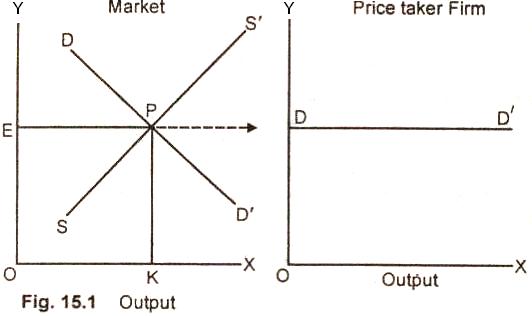Perfect Competition:
Definition:
The concept of perfect
competition was first introduced by Adam Smith in his book
"Wealth of Nations". Later on, it was improved by Edgeworth.
However, it received its complete formation in Frank Kight's
book "Risk, Uncertainty and Profit" (1921).
Leftwitch has
defined market competition in the following words:
"Prefect competition is a
market in which there are many firms selling identical products
with no firm large enough, relative to the entire market, to be
able to influence market price".
According to Bllas:
"The perfect competition is
characterized by the presence of many firms. They sell
identically the same product. The seller is a price taker".
The main conditions or
features of perfect competition are as under:
Features/Characteristics or
Conditions:
(1) Large number of firms.
The basic condition of perfect competition is that there are
large number of firms in an industry. Each firm in the industry
is so small and its output so negligible that it exercises
little influence over price of the commodity in the market. A
single firm cannot influence the price of the product either by
reducing or increasing its output. An individual firm takes the
market price as given and adjusts its output accordingly. In a
competitive market, supply and demand determine market price.
The firm is price taker and output adjuster.
(2) Large number of buyers.
In a perfect competitive market, there are very large number of
buyers of the product. If any consumer purchases more or
purchases less, he is not in a position to affect the market
price of the commodity. His purchase in the total output is just
like a drop in the ocean. He, therefore, too like the firm, is a
price taker.
In the figure (15.1) PK is the
market price determined by the market forces of demand and
supply. The price taker firm has to adjust and sell its output
at Price PK or OE.
Diagram/Figure:

(3) The product is homogeneous.
Another provision of perfect competition is that the good
produced by all the firms in the industry is identical. In the
eyes, of the consumer, the product of one firm (seller) is
identical to that of another seller. The buyers are indifferent
as to the firms from which they purchase. In other words, the
cross elasticity between the products of the firm is infinite.
(4) No barriers to entry. The
firms in a competitive market have complete freedom of entering
into the market or leaving the industry as and when they desire.
There are no legal, social or technological! barriers for the
new firms (or new capital) to enter or leave the industry. Any
new firm is free to start production if it so desires and stop
production and leave the industry if it so wishes. The industry,
thus, is characterized by freedom of entry and exit of firms.
(5) Complete information.
Another condition for perfect competition is that the consumers
and producers possess perfect information about the prevailing
price of the product in the market. The consumers know the
ruling price, the producers know costs, the workers know about
wage rates and so on. In brief, the consumers, the resource
owners have perfect knowledge about the current price of the
product in the market. A firm, therefore, cannot charge higher
price than that ruling in the market. If it does so, its goods
will remain unsold as buyers will shift to some other seller.
(6) Profit maximization. For
perfect competition to exist, the sole objective of the firm
must be to get maximum profit.
Importance:
Perfect competition model is hotly
debated in economic literature. It is argued that the model is
based on unrealistic assumptions. It is rare in practice. The
defenders of the model argue that the theory of perfect
competition has positive aspect and leads us to correct
conclusions. The concept is useful in the analysis of
international trade and in the allocation of resources. It also
makes us understand as to how a firm adjusts its output in a
competitive world.
Distinction
Between Pure Competition and Perfect Competitions:
For a pure competition
to exist, there are three main requisites, i.e., (1) homogeneity
of product (2) large number of firms and (3) ease of entry and
exist of firms.
A perfect competition,
on the other hand, is made up of all the six postulates stated
earlier.
Relevant Articles:
|